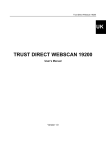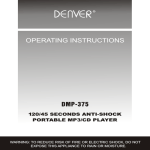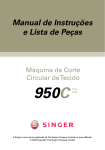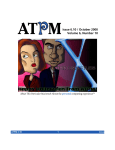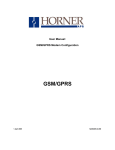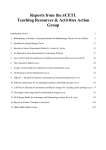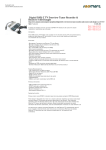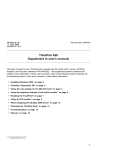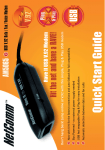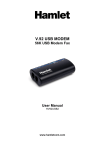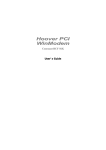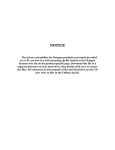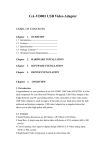Download USB Modem User`s Manual
Transcript
USB Modem User’s Manual
REVISION 1.2
WIRELINE DIVISION
NORTH AMERICA DEVELOPMENT APPLICATION GROUP
August 1998
1/35
STMicroelectronics
USB Modem User’s Manual
TABLE OF CONTENTS
1. INTRODUCTION
2. MINIMUM SYSTEM REQUIREMENTS
3. FEATURES
3.1 Data Protocols
3.2 Data Speed
3.3 Data Compression
3.4 Error Correction
3.5 Fax Protocols
3.6 Fax Speed
3.7 General
4. FEATURES CURRENTLY NOT SUPPORTED
5. INSTALLATIONS
6. COUNTRY CODE SETTINGS
7. AT COMMAND SETS
7.1 Basic AT commands
7.2 AT& Commands
7.3 AT\ Commands - Error Correction Control
7.4 AT% Commands
7.5 AT+MS Commands
7.6 AT+F Commands - Fax Support
7.7 AT# Commands - Voice Modem Support
7.8 S-Registers
8. REGULATORY INFORMATION
2/35
STMicroelectronics
USB Modem User’s Manual
1. INTRODUCTION
The goal of this manual is to provide general information for the developers on evaluation of the ST USB
Modem. The USB provide a 12Mbps high bandwidth for virtually unlimited data throughput instead of
the legacy 16550 UART bottleneck with the traditional modems.
ST USB Modem is a very flexible modem that has one of the smallest real estate and power
consumption out on the market. Because of the simplicity of the modem design, the time to market is
quick and less overhead. With this modem, all the future feature driver updates will be a simple
software update. This product has been developed in cooperation with Smart Link Ltd, who ported
“USB-Modio”, its host based modem and system software into ST system and hardware platform. ST
USB modem provides an easy installation and a strong performance that reduces the Total Cost of
Ownership.
No power supply needed for the ST USB Modem
2. MINIMUM SYSTEM REQUIREMENTS
Ÿ
Pentium 166MMX
Ÿ
16 MB RAM
Ÿ
USB port
Ÿ
Win98 or NT5.0
3/35
STMicroelectronics
USB Modem User’s Manual
3. FEATURES
3.1 Data Protocols:
Ÿ
V.90, K56Flex, V.34, V.34bis, V.32, V.22bis, V.22, V.21, V.23, Bell 212A, Bell 103
3.2 Data Speed:
Ÿ
V.90 and K56Flex, 54k, 52k, 50k, 48k, 46k, 44k, 42k, 40k, 38k, 36k, 34k, 33.6k, 31.2k, 28.8k, 26.4k,
24k, 21.6k, 19.2k, 16.8k, 14.4k, 12k, 9600, 7200, 4800, 2400, 1200, 300
3.3 Data Compression
Ÿ
V.42bis, MNP5
3.4 Error Correction
Ÿ
V.42 LAPM, MNP2,3,4
3.5 Fax Protocols:
Ÿ
Group 3 Compatible, Class 1 fax: V.17, V.29, V.27ter, V.21
3.6 Fax Speed:
Ÿ
14.4k, 12k, 9600, 7200, 4800, 2400, 300
3.7 General:
Ÿ
Standard AT commands
Ÿ
V.8 and Automode
Ÿ
V.80
Ÿ
Virtual UART (460.8kpbs)
Ÿ
Caller ID
Ÿ
DTMF detection and generation
Ÿ
Wake-up on ring
Ÿ
ADPCM
Ÿ
OnNow Power Management
Ÿ
Low power consumption
Ÿ
Virtual DTE
Ÿ
Distinctive ring for data/fax/voice
Ÿ
World wide country support
Ÿ
Answering machine (voice)
4/35
STMicroelectronics
USB Modem User’s Manual
4. FEATURES CURRENTLY NOT SUPPORTED
Ÿ
Call waiting
Ÿ
Class 2 fax
Ÿ
Full duplex speaker phone
5. INSTALLATIONS
Start your PC as usual, then plug in ST USB Modem to any spare USB port on your system. Windows
will report that it has found a new hardware and will open the Add New Hardware Wizard reporting that it
searches for the new drivers for an Unknown Device.
Click on the Next button.
Windows will propose to search for the best drivers for your device.
5/35
STMicroelectronics
USB Modem User’s Manual
Click on the Next button. Insert ST USB Modem software CD-ROM or USB Modem driver diskette.
Select CD-ROM drive or Floppy disk drive in the Add New Hardware Wizard window and click the Next
button.
The SmartLink driver for USB Modem will be proposed.
6/35
STMicroelectronics
USB Modem User’s Manual
Click on the Next button. Windows will build a database for this device.
Click again on the Next button to finish the installation of the USB driver.
Windows will detect again a New Hardware and will install the Modem drivers.
7/35
STMicroelectronics
USB Modem User’s Manual
At the end of this installation process, the Device Manager panel of the System Properties will show the
addition of SmartLink USB Modio MV in the Modem section and SmartLink driver for USB Modem in the
USB section:
8/35
STMicroelectronics
USB Modem User’s Manual
Finally, double clik on the SmartLink USB Modio MV and choose the modem folder as shown below.
Make sure that the Maximum speed is set to 460800.
9/35
STMicroelectronics
USB Modem User’s Manual
6. COUNTRY CODE SETTINGS
Once the modem is installed correctly, launch smc.exe. Please choose the country that you are calling
from as displayed by the following. With this program, you can take the ST USB modem and be able to
dial from any country world wide.
Once your USB modem has been set up, plug it on the telephone network
10/35
STMicroelectronics
USB Modem User’s Manual
7.0 - AT COMMAND SETS
Modem operation is controlled by AT commands. These AT commands include the following:
-
basic AT commands, for example ATDT123
-
extended AT commands, for example AT&E, AT\A, AT%C, AT+MS
-
S-Register commands, for example ATS0=1
-
Fax Class 1 commands, for example AT+FTM
-
Voice commands, for example AT#VTX
The command syntax and operation guidelines for each command category are described in the
following sections.
A command line is a string of characters sent from a DTE (Terminal or Data Terminal Equipment) to the
DCE (Data Terminal Circuit Equipment) while the DCE is in command state. Command lines have a
prefix, a body and a terminator. The prefix consists of the ASCII character AT or at. The body consists of
printable ASCII characters. Space characters other than <CR> (see register S3) and <BS> (see register
S5) are ignored. <CR> is command terminator.
Characters preceding the AT prefix are ignored.
AT Command Guidelines:
-
Basic AT commands consist of single ASCII characters which may be preceded by a prefix character,
for example &, and followed by a decimal number, for example AT&W1.
-
Missing decimal parameters are interpreted as 0. For example, if ATH is typed, the command ATH0
is assumed.
-
Fax commands are preceded with the +F characters and terminated by semicolon (;) or <CR>
character.
-
the modem supports editing command lines by recognising the <BS> character.
-
The AT command sequence may be followed by any number of commands in sequence, with the
exception of commands Z, D or A where all characters following on the same command line will be
ignored.
-
When a syntax error is found in the command line an ERROR response will be returned to the DTE.
Execution of commands D and A will be aborted if another character is entered before completion of
the handshake.
-
When the modem has entered on-line data mode, it is possible to break the data transmission in
order to issue more AT commands. This is done by the DTE sending a sequence of three escape
characters defined in S2, ‘+’ by default.
The modem will comply with the commands listed below. Parameters applicable to each command are
listed below. Default factory configuration settings are marked by an asterisk *.
Features marked with (-) are not yet available in current version of Modio.
11/35
STMicroelectronics
USB Modem User’s Manual
7.1 - Basic AT Commands
A/
Re-execute Command
The modem repeats the last command line sent by the DTE. Usually used for re-dialing.
Note: This command should not be terminated by <CR>.
A
Answer
The modem will go off-hook and attempt to answer an incoming call. Upon successful
completion of handshake, the modem will go on-line in answer mode.
Notes:
If +FCLASS=0 is selected, the modem will enter the connect state after exchanging carrier with
the remote system. If no carrier is detected within the period specified in S7, the modem hangs
up. Any character entered while connecting will abort the connection process.
If +FCLASS=1, the modem will go off-hook in V21 answer mode. It will generate the V21 2100
Hz answer tone for 3 +/- 0.5 seconds, and following a delay of 70 ms, will proceed as if the
+FTH=3 command were issued. At any stage up to (but excluding) the +FTH=3 command state,
any character will abort the communication.
If +FCLASS=8 (#CLS=8), the modem will go off-hook and a voice session will take place.
Related S-Reg: S0
Bn
CCITT Control
B0
Connect at V.22 1200 bps
Result codes:
OK
n=0
Error Otherwise
Dn
T
Dial
Directs the modem to go on-line, dial according to the string entered, and attempt to establish a
connection.
The Dial String may consist of any of the characters described below:
Tone dialing (first character in the string)
P
Pulse dialing (first character in the string)
L
Redial last dialed number (first character in the string)
0-9
Digits 0 to 9.
*
Asterisk (tone only)
#
Hash (tone only)
W
Wait for dial tone; the modem will wait for dial tone before dialing the digits following
"W". S6 register will be used for timeout. (X3 or higher)
,
(Comma); Pause for the time specified by S8 before resuming the dialing
;
(Semicolon) Return to command mode after dialing. This allows the user to issue
additional AT commands while remaining off-hook. Actual call progress will be entered
only after a dial command issued without the ";" terminator.
S=n
Dial the number stored in the directory; n=0-3 (see &Z).
!
(NA in V1.0x) Flash; The modem will go on hook for a time defined by S24.
@
(NA in V1.0x) Wait for silence; The modem will wait for at least 5 seconds of silence
before resuming the dialing. If no such silence is detected before the expiration of the
call abort timer (S7), the modem will terminate with NO ANSWER response (or BUSY if
12/35
STMicroelectronics
USB Modem User’s Manual
applicable). If answer tone arrives during execution of this parameter, the modem
handshakes. (X3 or higher)
(space) String format characters - ignored
any other character - ignored.
(),< >
<i>
Notes:
If +FCLASS=0 is selected, the modem will attempt to connect with another data modem. The
modem will use the time period specified in S6 and S7 as time-outs in the handshake process. If
a timeout expires, the modem will go on-hook and respond with NO CARRIER response. The
command will be aborted in progress is a DTE character is entered before completion of the
handshake.
If +FCLASS=1, the modem will attempt to connect with a fax machine (or modem) by entering
the HDLC V21 channel 2 receive state (as if +FRH=3 had been issued).
The command will be aborted upon receipt of a DTE character if the modem has not finished
dialing. In this case the modem will go on-hook and return to command mode responding with
NO CARRIER message. If the modem has finished dialing, It proceeds as if +FRH=3 command
has been issued.
If +FCLASS=8 (#CLS=8), the modem will go off-hook in V21 answer mode. It will decide (based
on timers) when the other side answers in voice and a voice session will take place.
Related S-Reg: S5,S6,S7,S16,S22,S28,S56
En
E1
Hn
Set local echo
The modem enables/disables echo of characters to DTE.
Parameter value is written to S13.
E0
Disable command echo.
Enable command echo (Default)
Result codes:
OK
n=0 or 1
Error Otherwise
Related S-Reg: S13
Set ON/OFF hook
H0
Modem hangs up (goes on-hook).
H1
Modem goes off hook.
Result codes:
OK
n=0 or 1
Error Otherwise
In
Identification/Information
I1
I2
I3
Modem Name, Vendor Name, Modem Version, for example:
ModemX Data,Fax,Voice Combo
1.23
SW Provider /SW Version, for example:
Smartlink Ltd.
1.23
Chip Vendor/Chip ID
ST Microelectronics
13/35
STMicroelectronics
USB Modem User’s Manual
I4
I5
I6
I7
Ln
L1
Mn
M1
Nn
N1
Modem active profile for example:
Active Profile:
S00=000 S01=000 S02=000 S03=000 S04=000 S05=000 S06=000 S07=000 S08=000
S00=009 S10=000 S11=000 S12=000 S13=000 S14=000 S15=000 S16=000 S17=000
S18=000 S01=019 S20=000 S21=000 S22=000 S23=000 S24=000 S25=000 S26=000
S27=000 S28=000 S29=000 S30=000 S31=000 S32=000 S33=000 S34=000 S35=000
S36=000 S37=000 S38=000 S39=000 S40=000 S41=000 S42=000 S43=000 S44=000
S45=000 S46=000 S47=000
Stored profile 0
Active Profile 0:
(Same format as above)
Stored profile 1
Active Profile 1:
(Same format as above)
Display stored pone numbers
(See &Z command)
Speaker volume
Select speaker volume.
L0
Low
Low (Default)
L2
Medium
L3
High
Result codes:
OK
n=0-3
Error Otherwise
Related S-Reg: S30
Speaker control
Select when the speaker is On/Off.
M0
Speaker always OFF
Speaker ON from start of dialing until receiving carrier (Default)
M2
Speaker always ON
M3
Speaker OFF from end of dialing until receiving carrier
Result codes:
OK
n=0-3
Error Otherwise
Related S-Reg: S29
Automode control
Enable/Disable Automode detection.
N0
Automode detection disabled. A subsequent handshake will be conducted according to
the contents of S32.
Automode enabled. A subsequent handshake will be conducted according to the Automode
algorithm (Default)
Result codes:
14/35
STMicroelectronics
USB Modem User’s Manual
OK
n=0 or 1
Error Otherwise
Related S-Reg: S31
On
Returns to on-line data mode
This command is normally used to connect the DTE back after an escape (+++) has been
issued.
O0
Return to on-line data mode.
O1
Return to on-line data mode, retrain first.
Result codes:
OK
n=0-1
Error Otherwise
P
Pulse dialing
Forces pulse dialing. Applies to subsequent dialing commands.
This command holds until the next T dial modifier or T command is received.
The modem will go off hook and attempt to answer an incoming call. Upon successful
completion of handshake, the modem will go on-line in answer mode.
Related S-Reg: S16
Q
Quiet result codes control
Q0
Enable sending result codes to DTE (Default).
Q1
Disable sending result codes to DTE.
Result codes:
OK
n=0 or 1
Error Otherwise
Related S-Reg: S14
S
Read/Write S-Register
This command has a few derivatives:
Sn=v Sets the value v (decimal) to S-register n (v=0-255)
Sn?
Displays the value of S-register in decimal format (3 digits)
Note: Some registers are read-only
Result codes:
OK
All parameters valid
Error Invalid S register or value. Trying to write to a read-only register
T
Tone dialing
Forces tone dialing. Applies to subsequent dialing commands. This command holds until the
next T dial modifier or T command is received.
This command changes S14 to reflect the current dialing mode.
Related S-Reg: S16
Vn
Verbose/Numeric result codes
Select the time of result messages sent to the DTE.
For a list of result codes and verbal messages see X command.
V0
Short form (numeric) result codes to be sent to DTE.
15/35
STMicroelectronics
USB Modem User’s Manual
V1
Long form (verbose) result codes to be sent to DTE (Default).
Result codes:
OK
n=0 or 1
Error otherwise
Related S-Reg: S15
Xn
Extended result codes
X4
Select the subset of result codes to be used by the modem to the DTE.
If the modem is in fax mode (+FCLASS=1), the only message sent to indicate connection is
"CONNECT" without a speed indication.
X0
Supported messages: OK, CONNECT, RING, NO CARRIER and ERROR, Blind call
enabled.
X1
Supported messages: OK, CONNECT xxxx, RING, NO CARRIER and ERROR, Blind
call enabled.
X2
Same as X1 + NO DIAL TONE message, Blind call disabled
X3
Same as X1 + BUSY message, Blind call enabled.
All messages supported, Blind call disabled (Default).
Notes:
W,@ dial modifiers are ignored in X1, X2
S6 (Wait before dial) is ignored in X2, X4 if no W is specified in dial string
S6 is set to 0 means a blind call
Table 1: Result Codes and Messages
Result
Code
Message
X0
x1
x2
x3
x4
0
OK
*
*
*
*
*
1
CONNECT
*
*
*
*
*
2
RING
*
*
*
*
*
3
NO CARRIER
*
*
*
*
*
4
ERROR
*
*
*
*
*
5
CONNECT 1200
1
*
*
*
*
6
NO DIAL TONE
3
3
*
3
*
7
BUSY
3
3
3
*
*
8
NO ANSWER
3
3
3
*
*
9
CONNECT 0300
1
*
*
*
*
10
CONNECT 0600
1
*
*
*
*
11
CONNECT 2400
1
*
*
*
*
12
CONNECT 4800
1
*
*
*
*
13
CONNECT 7200
1
*
*
*
*
27
CONNECT 9600
1
*
*
*
*
14
CONNECT 12000
1
*
*
*
*
16/35
STMicroelectronics
USB Modem User’s Manual
15
CONNECT 14400
1
*
*
*
*
16
CONNECT 16800
1
*
*
17
CONNECT 19200
1
*
*
*
*
18
CONNECT 21600
1
*
19
CONNECT 24000
1
*
*
*
*
20
CONNECT 26400
1
*
*
*
*
21
CONNECT 28800
1
*
*
*
*
22
CONNECT 31200
1
*
*
*
*
40
CONNECT 32000
1
*
*
*
*
23
CONNECT 33600
1
*
*
*
*
24
CONNECT 34800
1
*
*
*
*
25
CONNECT 40000
1
*
*
*
*
26
CONNECT 42000
1
*
*
*
*
28
CONNECT 44000
1
*
*
*
*
29
CONNECT 46000
1
*
*
*
*
30
CONNECT 48000
1
*
*
*
*
31
CONNECT 50000
1
*
*
*
*
32
CONNECT 52000
1
*
*
*
*
33
CONNECT 54000
1
*
*
*
*
34
CONNECT 56000
1
*
*
*
*
66
COMPRESSION: CLASS 5
-
*
*
*
*
67
COMPRESSION: V.42BIS
-
*
*
*
*
69
COMPRESSION: NONE
-
*
*
*
*
70
FAX
*
*
*
*
*
71
DATA
*
*
*
*
*
76
PROTOCOL: NONE
-
*
*
*
*
77
PROTOCOL: LAPM
-
*
*
*
*
78
PROTOCOL: MNP
-
*
*
*
*
1021
MODULATION: V.21
-
*
*
*
*
1022
MODULATION: V.22
-
*
*
*
*
1032
MODULATION: V.32
*
*
*
*
1034
MODULATION: V.34
-
*
*
*
*
1103
MODULATION: B103
-
*
*
*
*
1122
MODULATION: V.22BIS
-
*
*
*
*
1132
MODULATION: V.32BIS
-
*
*
*
*
1134
MODULATION: V.34BIS
-
*
*
*
*
1212
MODULATION: B212
-
*
*
*
*
+F4
+FCERROR
*
*
*
*
*
17/35
STMicroelectronics
USB Modem User’s Manual
<*> message will be generated when n has been selected
<i> message will be replaced by message <i> when n has been selected
<-> message will not be generated when n has been selected.
Related S-Reg: S56
Yn
Y2
Zn
Select default configuration
Select the default user defined configuration.
Note: The default configuration is not loaded by Yn (See Zn)
Y0
Select user template 0
Y1
Select user template 1
Select factory setting 0 (Default)
Y3
Select factory setting 1
Related S-Reg: S161
Select user defined configuration
Select the user defined configuration.
Z0
Select default user template (as defined by Yn)
Z1
Select user template 0
Z2
Select user template 1
Z3
Select factory setting 0 (&F0)
Z4
Select factory setting 1 (&F1)
Result codes:
OK
n=0-5
Error Otherwise
Related S-Reg: S59
7.2 - AT& Commands
&An
&A0
&Cn
Connect message format
Select the format of the CONNECT message.
no extra messages besides CONNECT xxxxx (Default)
&A1
Add Modulation indicator:
V.21/ V.22/ V.22BIS/ V.32/ V.32BIS/ V.34/ V.34BIS/ B103/ B212
For example:
Modulation: V.34
&A2
Add Error Detection Protocol and Data Compression indicators.
For example:
Protocol: LAPM/MNP/NONE
Compression: CLASS 5/V.42BIS/NONE
&A3
Add Modulation Indicator + Error Detection Protocol + Data Compression indicators (see
above).
Related S-Reg: S70, S71
Control Carrier Detect (CD, RLSD) behavior
Controls the RLSD output behavior.
18/35
STMicroelectronics
USB Modem User’s Manual
&C1
&Dn
&D1
&En
&C0
RLSD is assumed to be ON all the time
RLSD follows the carrier state (Default)
Result codes:
OK
n=0 or 1
Error Otherwise
Related S-Reg: S60
Controls DTR behavior (NA)
Controls the DTR output behavior.
Note: This command is supported for compatibility. It has no significance in Modio
environment.
&D0
DTR is taken to be ON all the time
DTR drop causes entry to command mode without disconnect (Default)
&D2
DTR follows DTR circuit definition
&D3
DTR drop causes software reset (as in Z0)
Result codes:
OK
n=0-3
Error Otherwise
Related S-Reg: S63
Connect message speed source
Select the requested source for the speed field in the CONNECT message.
&E0
DCE Speed
&E1
DTE Speed
Note: Since a virtual port is involved, the DTE is not bound by any UART limitation and may
be theoretically set as high as 921600. DTE speed is supported for compatibility only. It
bears little significance in Modio environment.
Related S-Reg: S71
&Fn
Sets factory configuration
Select one of the factory settings.
&F0
Select factory setting 0
&F1
Select factory setting 1
Result codes:
OK
n=0-1
Error Otherwise
Related S-Reg: S59
&Hn
&H1
Sets flow control
Select the user defined configuration.
&H0
Flow control disabled (NA)
"HW" flow control RTS/CTS emulation (Default)
Result codes:
OK
n=0-1
Error Otherwise
Related S-Reg: S62
19/35
STMicroelectronics
USB Modem User’s Manual
&Pn
Set pulse dial make/break ratio
&P0
US & Canada 39%/61% (10 pps) (Default)
&P1
UK & Hong Kong 33%/67% (10 pps)
&P2
Same as 0, except at 20 pps
&P3
Same as 1, except at 20 pps
Result codes:
OK
n=0-3
Error Otherwise
Related S-Reg: S28
&Rn
Controls RTS behavior
Controls the RTS output behavior.
Note: This command is supported for compatibility. It has no significance in Modio
environment
&R0
RTS ignored
&R1
Modem receives data only on RTS (NA)
Result codes:
OK
n=0 or 1
Error Otherwise
Related S-Reg: S61
&Sn
Controls DSR behavior
Note:
This command is supported for compatibility. It has no significance in Modio
environment.
&S0
DSR override (is assumed to be ON all the time)
&S1
DSR follows circuit definition
Result codes:
OK
n=0 or 1
Error Otherwise
Related S-Reg: S64
&Tn
Test mode
&T0
TBD (Default)
&T1
TBD
&T2
TBD
&T3
TBD
Result codes:
OK
n=0-3
Error Otherwise
Related S-Reg: S18, S50-S55
&V
Display Verbose Information
Display Active profile, Stored Profiles, Stored Phone Numbers
(Equivalent to I4-I7 combined)
&Wn
Writes current configuration
20/35
STMicroelectronics
USB Modem User’s Manual
&W0 Write to template 0
&W1 Write to template 1
Result codes:
OK
n=0-1
Error Otherwise
Written to registry.
&Zn
Stores dial string
Stores/Displays dial string (up to 47 characters)
&Zn=s Store dial string (n=0-4)
&Zn=L Store the last dialed string (n=0-4)
&Zn? Display the nth string
&ZL? Display the last dialed string
Written to registry.
7.3 - AT \ Commands - Error correction control
\An
\A1
\Bn
Maximum MNP block Size
\A0
64 characters maximum block size
128 characters maximum block size
\A2
192 characters maximum block size
\A3
256 characters maximum block size
Result codes:
OK
n=0-3
Error Otherwise
Related S-Reg: S<basereg+1> of V.42 registers
Transmit break to remote (-)
In non-error correction mode, the modem will transmit a break signal to the remote modem with
a length of n*100ms. If a number above 9 is entered, 9 is used.
Result codes:
OK
if connected in data modem mode
Error if not connected or if connected in fax modem mode
\Kn
\K5
Break Control (-)
Controls the response of the modem to a break received from DTE or a remote modem or the
\Bn command.
The behavior parameter is written to Sxx
\K0
Enter on-line command mode, no break sent to remote modem
\K1
Clear data buffers and send break to remote modem
\K2
Same as 0
\K3
Send break to remote modem immediately
\K4
Same as 0
Send a break to remote modem in sequence with transmitted data (Default)
Related S-Reg: S<basereg+x> of V.42 registers
21/35
STMicroelectronics
USB Modem User’s Manual
Result codes:
OK
n=0-5
Error Otherwise
\Nn
\N4
Error correction operating mode
\N0
Normal (Speed buffering) - No error correction
\N1
Direct (pass-through) 128 characters maximum block size
\N2
Reliable (error correction) mode. The Modem will attempt LAPM and then MNP
\N3
Auto reliable mode. Same as \N2, but will fall back to Normal
LAPM error correction mode only, hang up upon failure (Default)
\N5
MNP error correction mode only, hang up upon failure
Result codes:
OK
n=0-5
Error Otherwise
Related S-Reg: S<basereg> of V.42 registers
7.4 - AT% Commands
%Cn
%C3
%En
%E1
Compression control
%C0 Disable data compression
%C1 Enable MNP5 data compression
%C2 Enable V.42bis data compression
Enable MNP5/V.42bis data compression (Default)
Result codes:
OK
n=0-3
Error Otherwise
Related S-Reg: S<basereg+2> of V.42 registers
Line quality monitor control
Controls whether or not the modem will automatically monitor the line quality and request a
retrain (%E1), or fall back when quality is insufficient or fall forward when line quality improves
(%E2).
%E0 Disable line quality control
Enable line quality control and auto retrain
%E2 Enable line quality control and fallback/forward
Result codes:
OK
n=0-3
Error Otherwise
Related S-Reg: S39
7.5 - AT+MS Command
+MS
Modulation select
This command selects the modulation, optionally enables/disables Automode, and optionally
specifies the lowest and highest connection rates.
The command format is:
22/35
STMicroelectronics
USB Modem User’s Manual
AT+MS= [<mod>][,[<automode>][,[<min_rate>][,[<max_rate>]]]]
<mod>
a decimal number specifying the preferred modulation (automode
enabled), or the modulation (automode disabled).
<automode>
0/1 Automode disabled/enabled
<min_rate>
minimum rate for connection. If lower than the actual minimum rate for the
selected modulation, the actual lowest supported rate will be taken.
<max_rate>
maximum rate for connection. If higher than the actual maximum rate for the
selected modulation, the actual highest supported rate will be taken.
Table 2: +MS command parameters
<mod>
Modulation Possible rates
22
V.22
122
V.22bis
2400, 1200
32
V.32
9600, 4800
132
V.32bis
34
V.34
212
Bell 212
1200
103
Bell 103
300
Examples:
AT+MS=34,0,4800,33600
AT+MS=,1
AT+MS=32,1,,14400
1200
14400, 12000, 9600, 7200, 4800
33600, 31200, 28800, 26400, 24000, 21600,
19200,16800, 14400, 12000, 9600
V.34, No Automode, Min. speed 4800, Max speed 33600
Automode
V.32 Automode, Max speed 14400 (min speed as before)
Factory Settings: 34,1,300,33600
The requested modulation scheme will be written to S32
The requested min rate will be written to S33
The requested max rate will be written to S34
The actual rate may be read from S35
The actual modulation scheme may be read from S37
(codes as specified in the Xn command)
Other derivatives of the +MS command:
AT+MS?
report current MS settings (e.g. 34,1,9600,33600)
AT+MS=?
list the supported values +MS:(22,122.....), (0,1), (300-33600), (300-33600)
Result codes:
OK
Syntax OK
Error Otherwise
Related S-Reg: S31-S37
23/35
STMicroelectronics
USB Modem User’s Manual
7.6 - AT+F Commands - Fax Support
+FCLASS Data/Fax Class1/Voice mode
Sets Data/Fax Class1/Voice (0,1,8) mode
+FCLASS=<value>
[<value> - 0,1,8 (Data/Fax Class1/Voice]
Result codes:
OK
Syntax OK
Error Otherwise
+FCLASS? Returns current setting
Related S-Regs: S32, S150
+FAE Data/Fax Auto Answer
Select Data/Fax Auto Answer
+FAE=<value> [<value> - 0,1 (Data/Fax Class1)]
+FAE? Returns the current setting
Related S-Regs: S151
+FTS
Stop transmission and wait
+FTS= <value>
Terminates transmission and waits for <value>*10ms interval before responding with OK.
ERROR is issued if the modem is on-hook.
+FTS? Returns the current setting
+FRS Receive Silence
+FRS= <value>
Report back to DTE with OK after <value>*10ms silence interval has been detected. The
command is aborted if any character is received from the DTE (The response will still be OK).
ERROR is issued if modem is on-hook.
+FRS? Returns the current setting
+FTM Transmit Modulated Data
+FTM=<value>
Transmits data according to the defined modulation. ERROR is issued if modem is on-hook.
Value
24
48
72
73
74
96
97
98
121
122
145
Modulation
V.27 ter 2400 bps
V.27 ter 4800 bps
V.29 7200 bps
V.17 7200 bps long
V.27 7200 bps short
V.29 9600 bps
V.17 9600 bps long
V.17 9600 bps short
V.17 12000 bps long
V.17 12000 bps short
V.17 14400 bps long
24/35
STMicroelectronics
USB Modem User’s Manual
146
V.17 14400 bps short
+FTM=? Return "24, 48, 72, 73, 74, 96, 97, 98, 121, 122, 145, 146"
+FRM Receive Modulated Data
+FRM=<value>
Receives data according to the defined modulation (See Values above)
ERROR is issued if modem is on-hook.
+FRM=? Return "24, 48, 72, 73, 74, 96, 97, 98, 121, 122, 145, 146"
see +FTM
+FRH Receive HDLC Data
+FRH=<value>
Receives data using HDLC protocol and the defined modulation. ERROR is issued if modem is
on-hook.
<value> = 3 (V.21 channel 2 300 bps)
+FRH=? Return "3"
+FTH
Transmit HDLC Data
+FTH=<value>
Transmits data using HDLC protocol and the defined modulation. ERROR is issued if modem is
on-hook.
<value> = 3 (V.21 channel 2 300 bps)
+FTH=? Return "3"
7.7 - AT# Commands - Voice Modem Support
Note:
All the following commands will return OK as a result code (or ERROR if the parameters
are faulty), unless stated otherwise.
#BDR DTE Baud Rate
Sets DTE Baud Rate
#BDR=<value>
<value> - DTE Baud rate (0-48) *2400
#CID
Caller ID
Enables the Caller ID feature in any mode
#CID=<value>
#CID=0 - Disable Caller ID
#CID=1 - Enable Caller ID (Verbose)
#CID=2 - Enable Caller ID (Numeric)
Writes the value to Sreg
Related S-Reg: S75
#RG
Receive gain level
Sets receive gain level (effects the AUDIO IN level)
#RG=<value>
<value> - 0-7fff
25/35
STMicroelectronics
USB Modem User’s Manual
#TL
Transmit level
Sets transmit level (effects the AUDIO OUT level)
#TL=<value>
<value> - 0-7fff
#CLS
Data/Fax Class1/Voice mode
Same as +FCLASS=<value>
#CLS=<value>
Sets Data/Fax Class1/Voice (0,1,8) mode.
Related S-Regs: S32, S150
#VBS ADPCM or PCM
Bits per sample (ADPCM or PCM)
#VBS=<value> [<value> - 2,4 (ADPCM), 8,16 (PCM)]
#VBS? Returns the current setting
#VBS=? Returns "2,4,8,16"
Related S-Regs: S76
#VBT
Beep tone timer
Sets Beep tone timer for generating tones and DTMF
#VBT=<value> [<value> - 0-40 (* 1/10 ms)]
#VBT? Returns the current setting
#VBT=? Returns "0-40"
Related S-Regs: S77
#VIP
Voice Parameters
Initializes Voice Parameters
Related S-Regs: S75-S89
#VIT
Inactivity timer
Sets Inactivity timer
#VIT=<value> [0-255 (* 1/10 ms)]
#VIT? Returns the current setting
#VIT=? Returns "0-255"
Related S-Regs: S19
#VLS
Voice Source selection
Select Voice Source
#VLS=<value>
0 - Telephone Line Select (Go on hook)
2 - Speakers
3 - Microphone
6 - Speakerphone
#VLS? Returns the current setting
#VLS=? Returns "0,2,3,6"
26/35
STMicroelectronics
USB Modem User’s Manual
Result codes:
OK n=0, 6
VCON n=2, 3
ERROR Otherwise
(For 0, 6, VCON will be issued upon line connection)
Related S-Regs: S78
#VRA Ringback Goes Away Timer (originate)
This value is used during call progress to detect a voice answer.
This is the interval between ringback ending and voice answer determined.
#VRA=<value> [0-255 (*1/10 MS)]
#VRA? Returns the current setting
#VRA=? Returns "0-255"
Related S-Regs: S79
#VRN Ringback Never Came Timer (originate)
This value is used during call progress to detect a voice answer.
This is the interval without detection of ringback before voice answer is determined.
#VRN=<value> [0-255 (*1/10 MS)]
#VRN? Returns the current setting
#VRN=? Returns "0-255"
Related S-Regs: S80
#VRX Voice Receive Mode
Go to Voice Receive Mode
Result codes:
CONNECT Data may be sent
ERROR VLS=0,6 and line not connected
Note: Any input from the terminal will abort Voice Receive Mode
#VSD Silence deletion
Enables/Disables silence deletion (voice receive, ADPCM)
#VSD=<value> [0,1 - Disable/Enable]
#VSD? Returns the current setting
#VSD=? Returns "0,1"
Related S-Regs: S81
#VSP
Silence Period
Sets Silence Period (voice receive, ADPCM)
#VSP=<value> [0-255 (*1/10 ms)]
#VSP? Returns the current setting
#VSP=? Returns "0,255"
Related S-Regs: S83
#VSR Sample Rate
Sets Sample Rate (PCM, ADPCM)
27/35
STMicroelectronics
USB Modem User’s Manual
#VSR=<value> [7200, 11025, 8000]
#VSR? Returns the current setting
#VSR=? Returns "7200, 11025, 8000"
7200 is currently supported
Related S-Regs: S91
#VSS
Silence Sensitivity
Sets Silence Sensitivity (voice receive, ADPCM)
#VSS=<value> [0-3] (0-Disable, 3-allow noisy conditions
#VSS? Returns the current setting
#VSS=? Returns "0-3"
Related S-Regs: S82
#VTD
DTMF reporting capabilities
Sets DTMF reporting capabilities in Voice Transmit, Receive, and Voice Online Command
Modes
#VTD=<value><value><value> [0-3F]
#VTD? Returns the current setting
#VTD=? Returns "<0-3F>,<0-3F>,<0-3F>"
Bit
Description
0
Disable/Enable DTMF detection
1
Disable/Enable V.25 1300 Hz detection
2
Disable/Enable T.30 1100 Hz detection (Fax)
3
Disable/Enable V.25/T.30 2100 Hz detection (Modem)
4
Disable/Enable Bell 2225 Hz detection
5
Disable/Enable Busy/Dial tone detection
6-7
reserved
Related S-Regs: S84-S86
#VTM timing mark
Enables timing mark placement.
#VTM=<value> [0-10 (* 1/10 ms)]
#VTM? Returns the current setting
#VTM=? Returns "0-10"
Related S-Regs: S87
#VTS
tone signal
Generates a tone signal.
#VTS= [x,y,z] | {x,z} | x, ...
[x,y,z] x represents the first frequency (Hz)
y represents second frequency (Hz)
z represents the duration (in 100 ms units)
{x,z}
DTMF Digits with Variable Duration.
x represents the DTMF digit (0-9,A-D,*,#)
z represents the duration (in 100 ms units)
28/35
STMicroelectronics
USB Modem User’s Manual
x
DTMF Digits, with duration defined by #VBT. This is represented by a value x
(non-bracketed) corresponding to a DTMF digit (0-9,A-D,*,#).
#VGT Playback Volume
Sets Playback Volume [Default 192]
#VGT=<value> [0-255 (*1/10 ms)]
#VGT? Returns the current setting
#VGT=? Returns "0-255"
Related S-Regs: S74
#VTX
Voice Receive Mode
Go to Voice Receive Mode
Result codes:
CONNECT Data may be sent
ERROR VLS=0,6 and line not connected
#SPK Full Duplex Speakerphone
Sets Full Duplex Speakerphone parameters
#SPK=<mute>,<speaker>,<mic>
<mute> 0 Microphone Mute
1 Microphone On (default)
2 Room Monitor (mic on Max, Speaker off)
<speaker>
0-15 and 2-30 = dB attenuation
5 = default
16 = speaker mute
<mic> 0 - 0 dB gain
1 - 6 dB gain (Default)
2 - 9 dB gain
3 - 12 dB gain
Related S-Regs: S88-S90
29/35
STMicroelectronics
USB Modem User’s Manual
7.8 - S Registers
S#
Function
Range
Units
W
Default
AT
S0
Rings to Auto-Answer
0-255
rings
*
0
A
S1
Ring Counter
0-255
rings
S2
Escape Character
0-255
ASCII
S3
CR Character
0-255
ASCII
13
S4
LF Character
0-255
ASCII
10
S5
BS Character
0-255
ASCII
8
S6
Wait Time for Dial Tone
2-255
s
*
2
D
S7
Wait Time for Carrier
1-255
s
*
60
D
S8
Pause Time for Dial (,)
0-255
s
*
2
D
S9
Carrier Detect Response Time
1-255
0.1s
*
6
S10
Carrier Loss Disconnect Time
1-255
0.1s
*
7
S11
DTMF Tone duration
50-255
0.001s
*
70
D
S12
Reserved
S13
Echo
0-1
*
1
E
S14
Quiet
0-1
*
0
Q
S15
Verbose
0-1
*
1
V
S16
Pulse/Tone
0-1
*
1
T,P,D
S17
Reserved
S18
Test Timer
0-255
s
*
0
&T
S19
System Inactivity Timer
0-255
min
*
0
S20
Reserved
S21
Break Length
0-9
100ms
*
9
S22
Origin/Answer
0-1
S23
XOFF
S24
Flash Timer
S25
Delay to DTR
S26
Character
(NA)
0
*
43
\B
0
0-127
0-255
ASC
II
*
*
0
19
Off (NA)
0-255
0.01
ms
*
RTS to CTS delay (NA)
0-255
0.01ms
*
1
S27
Auto Answer clear timeout
0-255
s
*
8
S28
Pulse Set/Break Ratio
0-4
*
0
&P,P,D
S29
Speaker Control
0-3
*
1
M
S30
Speaker Volume
0-3
*
1
L
S31
Automode Select
0-1
*
1
+MS
S32
Requested Modulation (DP)
*
34
+MS
Mod
Code
5
30/35
STMicroelectronics
USB Modem User’s Manual
S33
Requested MIN Speed
bps Code
*
+MS
S34
Requested MAX Speed
bps Code
*
+MS
S35
Actual Speed after CONNECT
bps Code
S36
Current Data Pump Status
Mod
Code
S37
Actual Modulation (DP)
Mod
Code
S38
Actual Rx Speed
S39
Line Quality Control
S40
Reserved
S41
Received Signal Level
S42
SNR
S43
Result Codes control
bps Code
0-2
*
2
%E
4
dB
*
0
*
3
X
S44
S45
Transmit Gain Level
S46-S49
Reserved
S50-S55
Reserved for Test
S56
Extended Code
S57
Reserved
S58
Reserved
S59
0-10
-dBM
&T
0-4
*
4
X
Current Setting (Zn,&Fn)
0-5
*
3
Z, &F
S60
CD
0-1
*
1
&C
S61
RTS
0-1
*
1
&R
S62
Flow Control
0-3
*
1
&H
S63
DTR
0-3
*
0
&D
S64
DSR
0-1
*
0
&S
0-1
*
1
&C
S65
S66
Circuit 106 (RTS)
0-1
0
S67
Circuit 107 (DSR)
0-1
0
S68
Circuit 109 (CD)
0-1
0
S70
CONNECT message format
0-1
*
0
&A
S71
CONNECT message speed source
0-1
*
0
&E
S72-S73
Reserved
S74
Playback Volume
tbd
S75
CID Enable
0,1
S76
ADPCM Bits Per Sample
S77
Beep Tone Timer
S78
Line Selection Duration
S69
#VGT
*
0
4,8,16
0-40
#CID
#VBS
1/10 s
0,2,3,6
20
#VBT
#VLS
31/35
STMicroelectronics
USB Modem User’s Manual
S79
Ring Goes Away Timer
0-255
1/10 s
70
#VRA
S80
Ring Never Came Timer
0-255
1/10 s
100
#VRN
S81
Silence Detect Enable
0,1
0
#VSD
S82
Silence Detect Sensitivity
0-3
2
#VSS
S83
Silence Detect Duration
0-255
55
#VSP
S84
Dtmf Tone Reports Cap0
0-3F
0
#VTD
S85
Dtmf Tone Reports Cap1
0-3F
0
#VTM
S86
Dtmf Tone Reports Cap2
0-3F
0
#VTM
S87
Time Mark Placement
0-255
0
#VTM
S88
SPK <mute>
0-2
1
#SPK
S89
SPK <speaker>
0-15
5
#SPK
S90
SPK <mic>
0-3
1
#SPK
S91
Voice Sample Rate
1,2
0
#VSR
S92
Reserved
S93-S99
Reserved for Diagnostics
S100-S149
Reserved for V42
S150
FCLASS Value
S151
FAE Value
S152-S160
Reserved
S161
1/10 s
1/10 s
1
1
\A,\N, %C
0,1,8
*
0
+FCLASS
0,1
*
0
+FAE
Default Setting
0-1
*
2
Y
S162
Country Type
0-7
S163-S169
Reserved
S170-S174
Debug Registers
S197-S199
Reserved for Diagnostics
1
*
2
32/35
STMicroelectronics
USB Modem User’s Manual
8.0 - REGULATORY INFORMATION
8.1 - FCC Registration
This device complies with Part 15 and Part 68 of the FCC rules. The Registration Number and Ringer
Equivalence Number (REN) are located on the bottom of your USB modem. You must provide this
information to the telephone company if requested.
The REN is used to determine the number of devices you may legally connect to your telephone line. In
most areas, the sum of the REN of all devices connected to one line must not exceed five (5.0). You
should contact your telephone company to determine the maximum REN for your calling area.
A variety of Universal Service Ordering Code telephone wall jacks are available for different types of
devices or services. Please note that the USOC jack required for this unit is RJ11.
The telephone company may change technical operations or procedures affecting your equipment. You
will be notified of changes in advance to give you ample time to maintain uninterrupted telephone
service.
If you experience trouble with this telephone equipment, please contact :
ST MICROELECTRONICS
2055 Gateway Place, Suite 700
San Jose, CA 95110
for information on obtaining services or repairs. The telephone company mat ask that you disconnect this
equipment from the network until the problem has been resolved. If your equipment continues to disrupt
the network, the telephone company may temporarily disconnect service. If this occurs you will be
informed of your right to file a complaint with the FCC.
This equipment may not be used on coin service provided by the telephone company. Connection to
party lines is subject to state tariffs.
An FCC compliant telephone cord and modular plug are provided with this equipment, which is designed
to connect to the telephone network or premises wiring using a compatible modular jack that is Part 68
complaint. See installation instructions for details.
FCC FAX BRANDING REQUIREMENTS
The Telephone Protection Act of 1991 makes it unlawful for any person to use a computer or other
electronic device to send any message via a telephone, fax machine, or modem unless such message
clearly contains in a margin at the top or bottom of each transmitted page or on the first page of the
transmission, the date and time it is sent and an identification of the business or other entity, or other
individual sending the message and the telephone number of the sending machine or such business,
other entity or individual.
Programming of this information is a function of the fax software which runs on your computer. In order
to program this information, please consult the documentation provided with your fax software.
33/35
STMicroelectronics
USB Modem User’s Manual
WARNING
This device complies with part 15 of the FCC Rules. Operation is subject to the two following conditions:
(1) this device may not cause harmful interference, and
(2) this device must accept any interference received, including interference that may cause undesired
operation.
RADIO AND TELEVISION INTERFERENCE
This equipment generates and uses radio frequency energy. If not installed and used in accordance with
the manufacturer’s instructions, it could cause interference to radio and television reception. It has been
tested and complies with the limits for a Class B computing device in accordance with the specifications
in Part 15 of the FCC Rules designed to provide reasonable protection against interference in a
residential installation. There is no guarantee that interference will not occur. If this equipment causes
interference to radio or television, as determined by turning the equipment off and on, the user is
encouraged to correct the interference by using the following measures:
* Reorient the receiving antenna
* Relocate the computer with respect to the receiver
* Plug the computer into a different outlet so the computer and receiver are on different branch circuits.
Changes or modifications to this unit not expressly approved by the party responsible for compliance
could void the user’s authority to operate the equipment.
If necessary, the user should consult the dealer or a radio/television technician for additional
suggestions. You may find the following booklet, prepared by the Federal Communications Commission
helpful:
How to identify and resolve radio-TV interference problems.
Stock No. 004-000-0345-4
U.S. Government Printing Office
Washington, DC 20402
SHIELDED CABLES
This product has been tested and complies with FCC limits for Class B computing device. Testing was
done with shielded computer cables. Using unshielded cables could cause your system to emit excess
radio frequency, increasing the chance of interference. To comply with FCC regulations it is necessary to
use shielded computer cables with your installation.
8.2 -INDUSTRY CANADA Registration
34/35
STMicroelectronics
USB Modem User’s Manual
This digital apparatus does not exceed the Class B limits for radio noise emissions from digital apparatus
set out in the interference-causing equipment standard entitled Digital Apparatus ICES-003 of Industry
Canada.
NOTICE: IC labels are affixed to each unit sold in Canada. This label has the certification number for
that particular unit. The numbers are different for each model. The Industry Canada label identifies
certified equipment. This certification means the equipment meets certain telecommunications network
protective, operational and safety requirements. The Department does not guarantee the equipment will
operate to the user’s satisfaction.
Before installing this equipment, users should ensure that it is permissible to be connected to the
facilities of the local telecommunications company. The equipment must also be installed using an
acceptable method of connection. In some cases, the company’s inside wiring associated with a
single-line, individual service may be extended by means of a certified connector assembly (telephone
extension cord). The customer should be aware that compliance with the above conditions may not
prevent degradation of service in some situations.
Repairs to certified equipment should be made by an authorised Canadian maintenance facility
designated by the supplier. Any repairs or alterations made by the user to this equipment, or equipment
malfunctions, may give the telecommunications company cause to request the user to disconnect the
equipment.
For your own protection, make sure that the electrical ground connections of the power utility, telephone
lines and internal metallic water pipe system, if present, are connected together. This precaution may be
particularly important in rural area.
CAUTION
Do not attempt to make such connections yourself. Instead contact the appropriate electric inspection
authority, or electrician, as appropriate.
RINGER EQUIVALENCE NUMBER
The Ringer Equivalence Number (REN) assigned to each terminal device provides an indication of the
maximum number of terminals allowed to be connected to a telephone interface. The termination on an
interface may consist of any combination of devices subject only to the requirement that the sum of the
Ringer Equivalence Number of all the devices does not exceed five (5.0)
35/35
STMicroelectronics






































